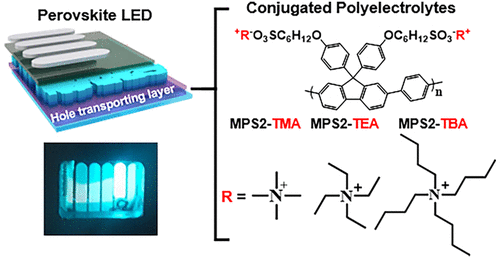Our official English website, www.x-mol.net, welcomes your feedback! (Note: you will need to create a separate account there.)
Sky-Blue-Emissive Perovskite Light-Emitting Diodes: Crystal Growth and Interfacial Control Using Conjugated Polyelectrolytes as a Hole-Transporting Layer.
ACS Nano ( IF 17.1 ) Pub Date : 2020-09-10 , DOI: 10.1021/acsnano.0c04968 Chung Hyeon Jang 1 , Amit Kumar Harit 2 , Seungjin Lee 3 , Su Hwan Kim 4 , Ji-Eun Jeong 2 , Jong Hyun Park 1 , Eui Dae Jung 1 , Jung Min Ha 2 , Sang Kyu Kwak 4 , Han Young Woo 2 , Myoung Hoon Song 1
ACS Nano ( IF 17.1 ) Pub Date : 2020-09-10 , DOI: 10.1021/acsnano.0c04968 Chung Hyeon Jang 1 , Amit Kumar Harit 2 , Seungjin Lee 3 , Su Hwan Kim 4 , Ji-Eun Jeong 2 , Jong Hyun Park 1 , Eui Dae Jung 1 , Jung Min Ha 2 , Sang Kyu Kwak 4 , Han Young Woo 2 , Myoung Hoon Song 1
Affiliation

|
A series of poly(fluorene-co-phenylene)-based anionic conjugated polyelectrolytes (CPEs) are prepared with varying sizes of counterions (tetramethylammonium, tetraethylammonium, and tetrabutylammonium (TBA+)) and studied as a hole-transporting layer (HTL) for sky-blue-emissive perovskite light-emitting diodes (PeLEDs). Ionic CPE HTLs improve the wettability, compatibility, and nucleation of perovskite crystals at interfaces, enabling highly crystalline perovskite crystal growth with enhanced light-emitting properties. By incorporating the CPE HTLs containing bulky TBA+ counterions (MPS2-TBA) in place of PEDOT:PSS, the decreased phonon–electron coupling and increased exciton binding energy in perovskites are measured by temperature-dependent photoluminescence (PL) measurements. By increasing the size of counterions in CPE interlayers, the PL intensities and lifetimes of perovskite films increase. Through space-charge-limited current measurements, the lowest trap density is measured in the perovskite film on MPS2-TBA, emphasizing a critical role of larger counterions. Using density functional theory, MPS2-TBA is calculated to show the strongest adsorption affinity toward the interstitial defect of lead ions, explaining its pronounced interfacial defect passivation. The counterion size in CPE interlayers is interpreted as a main factor to determine the adsorption affinity onto perovskite, which determines the interacted area as noncovalent adsorption occurs. Finally, the sky-blue-emissive quasi-2D PeLED with MPS2-TBA shows the highest luminance efficiency (a peak EQE of 2.6% at 489 nm) and significantly improved spectral stability.
中文翻译:

天蓝色发射钙钛矿型发光二极管:使用共轭聚电解质作为空穴传输层的晶体生长和界面控制。
制备了一系列具有不同大小的抗衡离子(四甲基铵,四乙基铵和四丁基铵(TBA +))的聚(芴-共-苯)基阴离子共轭聚电解质(CPE),并作为空穴传输层(HTL)进行了研究天蓝色发射钙钛矿型发光二极管(PeLED)。离子CPE HTL改善了钙钛矿晶体在界面处的润湿性,相容性和成核作用,从而实现了高结晶钙钛矿晶体生长并具有增强的发光性能。通过合并包含大量TBA +的CPE HTL通过依赖于温度的光致发光(PL)测量来测量钙钛矿中抗衡离子(MPS2-TBA)代替PEDOT:PSS,降低的声子-电子耦合和增加的激子结合能。通过增加CPE中间层中抗衡离子的大小,钙钛矿薄膜的PL强度和寿命增加。通过空间电荷限制电流测量,可以在MPS2-TBA上的钙钛矿薄膜中测量出最低的陷阱密度,从而强调了较大抗衡离子的关键作用。使用密度泛函理论,MPS2-TBA的计算显示出对铅离子间隙缺陷的最强吸附亲和力,从而说明了其明显的界面缺陷钝化。CPE中间层中抗衡离子的大小被解释为决定钙钛矿上吸附亲和力的主要因素,它决定了发生非共价吸附时的相互作用区域。最终,具有MPS2-TBA的天蓝色发射准2D PeLED显示出最高的亮度效率(在489 nm处的峰值EQE为2.6%)并显着提高了光谱稳定性。
更新日期:2020-10-28
中文翻译:

天蓝色发射钙钛矿型发光二极管:使用共轭聚电解质作为空穴传输层的晶体生长和界面控制。
制备了一系列具有不同大小的抗衡离子(四甲基铵,四乙基铵和四丁基铵(TBA +))的聚(芴-共-苯)基阴离子共轭聚电解质(CPE),并作为空穴传输层(HTL)进行了研究天蓝色发射钙钛矿型发光二极管(PeLED)。离子CPE HTL改善了钙钛矿晶体在界面处的润湿性,相容性和成核作用,从而实现了高结晶钙钛矿晶体生长并具有增强的发光性能。通过合并包含大量TBA +的CPE HTL通过依赖于温度的光致发光(PL)测量来测量钙钛矿中抗衡离子(MPS2-TBA)代替PEDOT:PSS,降低的声子-电子耦合和增加的激子结合能。通过增加CPE中间层中抗衡离子的大小,钙钛矿薄膜的PL强度和寿命增加。通过空间电荷限制电流测量,可以在MPS2-TBA上的钙钛矿薄膜中测量出最低的陷阱密度,从而强调了较大抗衡离子的关键作用。使用密度泛函理论,MPS2-TBA的计算显示出对铅离子间隙缺陷的最强吸附亲和力,从而说明了其明显的界面缺陷钝化。CPE中间层中抗衡离子的大小被解释为决定钙钛矿上吸附亲和力的主要因素,它决定了发生非共价吸附时的相互作用区域。最终,具有MPS2-TBA的天蓝色发射准2D PeLED显示出最高的亮度效率(在489 nm处的峰值EQE为2.6%)并显着提高了光谱稳定性。



























 京公网安备 11010802027423号
京公网安备 11010802027423号